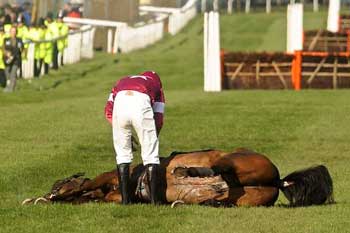Introduction
The Grand National horse race, & the horse racing industry in general, is the cause of great suffering to a huge number of horses: From horses that die on the race course, to ones killed, abandoned, neglected, starved and sold to be slaughtered for the horse meat industry. This happens to race horses when they are no longer of use to make money with, or when they do not meet expectations to begin with.
Many thousands of horses are produced annually in order to be able to generate a few particularly fast ones to compete in horse racing. Of the many thousands bred to race, very few make the grade. The fates of many of these horses are often cruel and brutal. This can also be true of ex-race horses, retired from competing because they no longer make money. Many are retired young, before even fully maturing.
Despite overwhelming evidence, many people refuse to believe that this goes on in the industry, due to not having witnessed it themselves.
Image: Horse falling over and getting trampled on during a race. Source

Ad:





